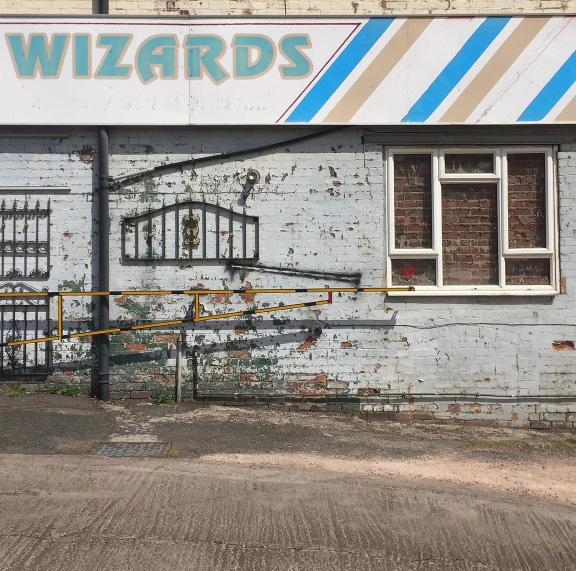 Leo Wilkins UWE Graphic Design
Leo Wilkins UWE Graphic Design
The Black Country
A book about the history of the Black Country focusing on three different aspects ranging from Symbolism throughout the Black country and how it is portrayed and used, culture in the Black Country and how it has developed to impact specific areas or people, to the Industrial history of the Black Country appearing in a abstract form.
Put into three different chapters, this book covers many different characteristics of the Black Country, attempting to inform the importance of the areas history and it’s significance in impacting today’s society and structure.

Chapter
Chapter
The Black Country is an industrial region closely corresponding to the small south Staffordshire coalfield in the Midlands region of England. It is made up of the boroughs of Dudley, Sandwell, Walsalll, West Bromwich and Wolverhampton, which surround the city of Birmingham. It’s name derives from its pollutioncoated industrial landscape where the black soot would emanate from its aforementioned factories. The Black Country extends immediately to the west of the city of Birmingham, which itself lies off the coalfield, and makes up the western part of the metropolitan county of West Midlands. The clusters of industrial towns that earned this appellation sprang up in the 18th century in the historic counties of Staffordshire and Worcestershire with the intense exploitation and local use of coal and iron ore resources. Collieries, blast furnaces, and foundries filled the air with smoke and grime. Coal mining ceased by the end of the 20th century. The region, including all or most of the metropolitan boroughs of Wolverhampton, Walsall, Dudley, and Sandwell, remains industrial in character and has become even more urbanized. Industrial activity has shifted from iron-making to metal-using plants, which no longer give rise to such extreme pollution. The industrial past has left its imprint on the landscape, however, and much derelict land may still be seen.
“No two Black Country men or women will agree on where it starts or ends.”All the Shop Fronts images in the following pages 008–021 have been gathered by--- Black CountryType website.
The Black Country has no single set of defined boundaries. Some traditionalists define it as the area where the coal seam comes to the surface – so West Bromwich, Coseley, Oldbury, Blackheath, Cradley Heath, Old Hill, Bilston, Dudley, Tipton, Wednesbury, and parts of Halesowen, Walsall and Smethwick or what used to be known as Warley.

There are records from the 18th century of shallow coal mines in Wolverhampton, however, others have included areas slightly outside the coal field which were associated with heavy industry. The borders of the Black Country can be defined by using the special cultural and industrial characteristics of the area.

Areas around the canals which had mines extracting mineral resources and heavy industry refining these are included in this definition. Cultural parameters include unique or characteristic foods such as groaty pudding, grey peas and bacon, faggots, gammon or pork hocks and pork scratchings; Black Country humour; and the Black Country dialect.

By the mid-twentieth century, the size of the industrial region centring on Birmingham and the Black Country and its large population led to attempts in government to subdivide the area into different boroughs, in order to give urban areas with a larger population more autonomy. The aim was to give these boroughs the power to regulate education, welfare, health services, libraries and roads.

In 1966, urban, county and rural districts were created and superimposed upon, and within, the shire counties: Staffordshire alone contained over twenty urban and rural districts, plus the three county boroughs of Walsall, Wolverhampton and West Bromwich.

From the 19th century onwards, the area gained widespread notoriety for its hellish appearance, a depiction that made its way into the published works of the time. Charles Dickens's novel The Old Curiosity Shop, written in 1841, described how the area's local factory chimneys "Poured out their plague of smoke, obscured the light, and made foul the melancholy air".

Black Country Type is Tom Hicks; an artist, writer and curator from Kingswinford. Black Country Type is an ongoing photographic project. In this series of images he applies his unique aesthetic to the region, focusing on words, typography, handmade lettering and signs. He also photographs ‘types’ of architectural features, objects and the post-industrial landscape of the area.
 The Black Country - Symbolism
The Black Country - Symbolism
"Black Country Type documents, as the name suggests, the vernacular and incidental typography of his native West Midlands. The vivid colours he captures somewhat contradict the idea of the ‘Black Country’ and there is definitive jolliness and humour, if somewhat plaintive, nature to his work" - The Modernist.

An avid reader and writer, Tom felt “naturally attracted to the written word” and combined with an interest in design, this led him to look for examples of classic typefaces and traditional signwriting in the region. He began to share his as exploration and visual record of the area north and west of Birmingham, including Dudley, Walsall and Sandwell, via social media.

His images also archive the cultural history of the area, the impact of industrial decline, and the disappearance of the high street. They show the traces that people leave in the environment, particularly with hand-painted signage and handwritten typography.

Many of the photographs are humorous, creating reactions in and conversations between viewers, both on and offline. Some people identify with the locations – shops, cafés and factories – as they remember them in their heyday. Tom’s photography has also come to the attention of magazines and he is featured in the Summer edition of Fused, the magazine dedicated to art, design and culture.

As well as creating conversations with local groups and people from the Black Country, Tom’s project has been receiving recognition and interest from many quarters, and particularly from graphic designers, architecture fans, historians and photographers. In 2018 this resulted in a number of exhibitions, including a solo show at Zellig in the Custard Factory as part of the Birmingham Design Festival and another at the Birmingham Midland Institute .

His practice reflects an interest in psychogeography and the idea of urban exploration is a key part of his way of working. Tom’s work showcases long forgotten typefaces, industrial graphics and traditional signwriting – as well as hand-scrawled graffiti. He also documents crumbling factories, long-faded architecture and the beauty of decaying surfaces.

His images are taken whilst cycling and he believes that the freedom of movement afforded by a bicycle has been essential to his work, in that is allows access to areas that are inaccessible to a car and that it allows him to explore large geographical areas in the space of a day.

In recent years the Black Country has seen the adoption of symbols and emblems with which to represent itself. The first of these to be registered was the Black Country tartan in 2009, designed by Philip Tibbetts from Halesowen.
In 2008 the idea of a flag for the region was first raised. After four years of campaigning a competition was successfully organised with the Black Country Living Museum. This resulted in the adoption of the Flag of the Black Country as designed by Gracie Sheppard of Redhill School in Stourbridge and was registered with the Flag Institute in July 2012.
The flag was unveiled at the museum on 14 July 2012 as part of celebration in honour of the 300th anniversary of the erection of the first Newcomen atmospheric engine. Following this it was agreed by the museum and Black Country society for 14 July to be recognised as Black Country Day to celebrate the area’s role in the Industrial Revolution. The day was marked by Department for Communities and Local Government in 2013 and following calls to do more in 2014 more events were planned around the region.
14th July
Black Country day -
Black Country Day takes place on 14 July each year. Originally in March, the day was later moved to 14 July — the anniversary of the invention of the Newcomen steam engine — and now coincides with a wider series of events throughout the month aimed at promoting Black Country Culture called the Black Country Festival.
The flag’s chain represents the manufacturing heritage of the area - specifically the chainmakers who were common during the Black Country’s industrial heyday. The white triangular shape is reminiscent of the glass cones (for example the Red House Cone in Wordsley) and iron furnaces common in Black Country architecture. And the red and black colours were inspired by the words of Elihu Burrit, the American consul to Birmingham, who in 1862 described the region as “black by day and red by night,” in reference to the industrial activity.
Gracie Sheppard, a schoolgirl from Stourbridge, designed the flag during a competition in the run-up to the Queen’s Diamond Jubilee and Olympic Games in 2012. A total of 66 designs were submitted and 12-year-old Gracie made a six-strong shortlist before winning a public vote for her flag to be flown at the Black Country Living Museum. At the time Gracie explained her design, saying: “Because the local furnaces gave out smoke and grime during the day and glowed at night. That is why my flag background is both black and red, with the chains showing a typical product manufactured in the area.

In 2015, social commentator and political activist Patrick Vernon described the flag as "offensive and insensitive" and said its chains were a 'disturbing' image of an industry that profited from the transatlantic slave trade and colonial rule in Africa.
Mr Vernon, who grew up in Wolverhampton, claimed the Black Country had shied away from addressing the role its industries played in slavery - saying the iconic chains were often used as shackles for slaves and the debate was brought up again in 2017 when recently-elected Labour MP Eleanor Smith called for the flag to be scrapped over its “offensive” imagery.
Ms Smith, the MP for Wolverhampton South West, used her maiden speech in the House of Commons to defend her stance, questioning whether it should be the Black Country’s “only brand image” However thousands of people, including Ms Smith’s parliamentary Labour colleagues from the Black Country, disagree and say the flag represents a key part of the region’s manufacturing heritage.
The issue returned in 2020 when West Midlands Fire Service banned its stations from flying the flag on Black Country Day due to “claims about the flag’s imagery and the potential link to slavery”. The service said it was “continuing to consider the information available about the flag.”
“offensive and insensitive"
2015, Wolverhampton-born historian and anti-racism campaigner Patrick Vernon OBE called for the design of the flag to be replaced, saying that “the Black Country factories and foundries made chains, shackles and manacles during slavery that were used in colonial Africa to enslave black people. The same factories employed people from the Caribbean and Asia during the 1950s and 60s on lower wages and poorer working conditions compared to their white counterparts. And of course the chain industry oppressed the white working classes too, so I feel the use of the chain logo is inappropriate in today’s world where we know the effects of this history”. Vernon later said that the reaction to his comments on the Express Star website and harassment on his Twitter account reflected “a degree of scepticism and criticism of ‘political correctness gone mad’ in suggesting that the Black Country ever had some involvement in the slave trade. Again this highlights that we have not matured or reflected as a nation on our colonial past which has an impact both on black and white people”.
Shortly after her election to the House of Commons, Wolverhampton South West Member of Parliament Eleanor Smith was reported to have criticised the design of the flag because of the association of locally-made chains with the slave trade and to have suggested that the design of the flag be changed. The controversy was the subject of a question in Prime Minister’s Questions, in which Theresa May defended the flag, saying “The Black Country remains a great place to do business, and I’d like to congratulate Gracie on designing that flag at the age of only 12 years. And I have to say that I am sure that she and others, including the Express Star, have been surprised at the attitude from the benches opposite on this particular issue”. In 2018, a man from Castlecroft, an area within Smith’s constituency, was given a nine-week suspended prison sentence for sending racist and threatening emails to several MPs, including Smith, in which he told her to be put on “the first banana boat” to “the jungle clearing you came from”. Both the prosecution and defence cited Smith’s reported comments about the flag as having motivated the abusive emails.
Writing in The Guardian in July 2017, activist Matthew Stallard, a former University of Manchester student, claimed that it was “a historical fact that the Black Country was a key provider of metalworked goods to the slave trade and plantation economies of the Americas and throughout the British Empire. Scholars have consistently demonstrated the inherently interlinked nature of industrial development in all areas of the UK and imperial expansion, whether directly by trading British goods for people, using slave-produced raw materials, or the sale and use of Britishmade goods in slave or colonial economies”. He added, “An effort to create a truly inclusive local identity requires a less defensive stance than the one demonstrated by the local press in recent days – one that is at the very least open to listening to and trying to understand the experiences and historical viewpoints of others”.

Within the geographical areas under consideration in this volume, at least two main dialect types can be identified: those of Birmingham to the east, and those of the Black Country to the west. The geographical boundaries of the city of Birmingham are clearly delineated. The most commonly cited ways of defining the area have been to use the limits of the various industries carried out in the region. Thus Gale remarks that the area is ‘probably as well known as it is certainly ill-defined’. He is aware that the Black Country has ‘neither physical nor political boundaries’ but considers that confusion need not exist, for ‘if a proper basis is chosen, and if it is used logically, definition to quite close limits becomes possible’. He attempts this, yet his final decision is still distinctly nebulous. He considers that the Black Country is a group of industrial towns and villages, now an almost continuous urban concentration lying to the north-west of the city of Birmingham. It is mainly in the southern part of the county of Staffordshire, though a portion lies in the north of Worcestershire, and it actually adjoins Birmingham on one side.





